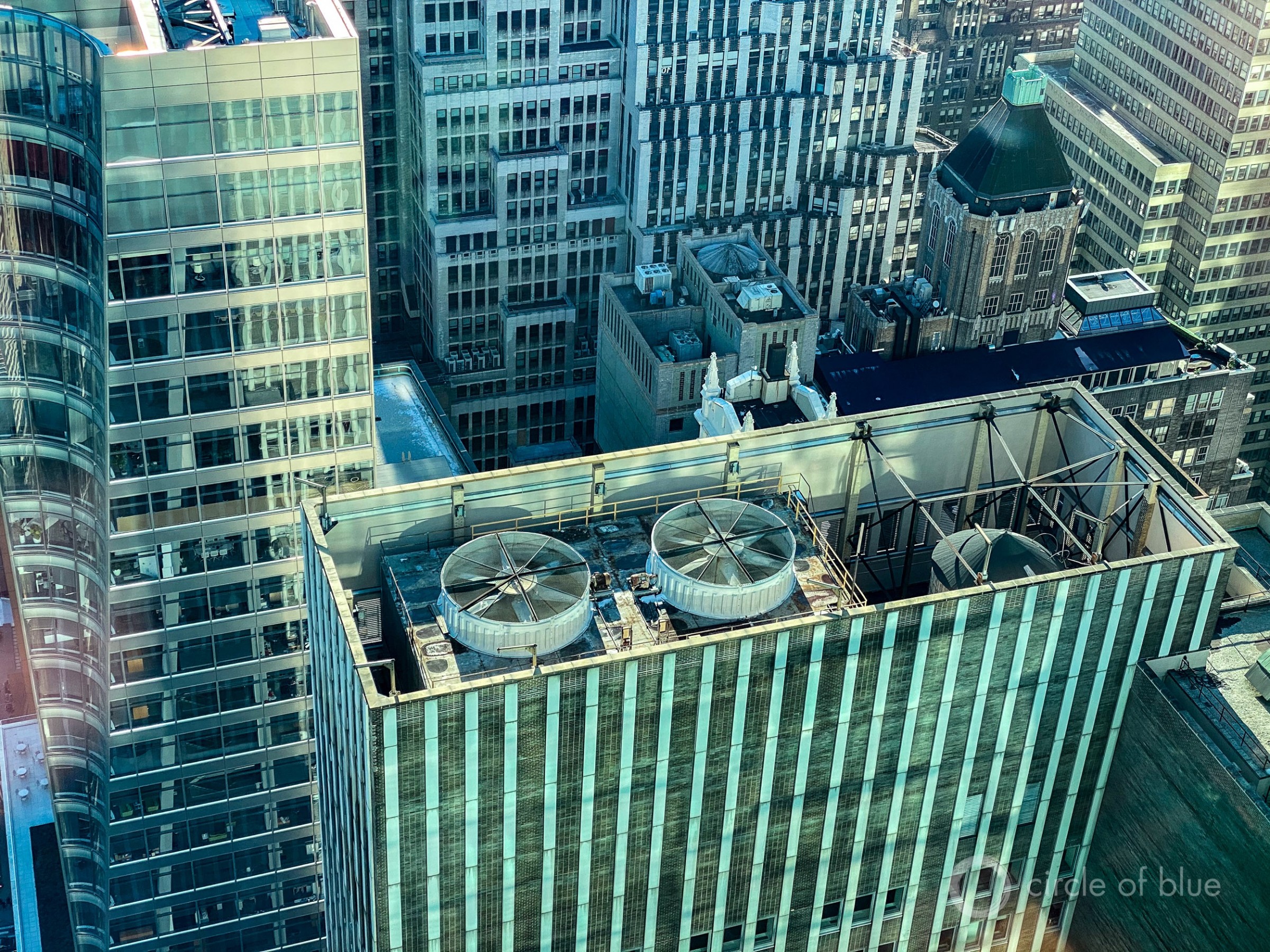CDC, EPA Change Building Reopening Guidance After Acknowledging Error
Agencies admit incorrect guidance in documents intended to protect people from a deadly waterborne disease.

Cooling units perch atop a building in New York City. The prolonged shutdown of commercial districts in cities nationwide has increased the risk of water contamination in large buildings, researchers say. Photo © J. Carl Ganter/Circle of Blue
By Brett Walton, Circle of Blue
Two federal agencies charged with protecting the health of U.S. residents during the coronavirus pandemic have acknowledged that their guidance for safely reopening buildings that were closed because of state shutdown orders was flawed and that they have revised it.
The Centers for Disease Control and Prevention and the Environmental Protection Agency incorrectly stated the proper temperature setting for water heaters in offices, hotels, restaurants, schools, and other large buildings with complex plumbing systems.
“It’s absolutely, critically important. That saved lives,” Tim Keane, a nationally recognized plumbing specialist.
The errors, now corrected, put people at risk of contracting Legionnaires’ disease, plumbing experts said. Legionnaires’ disease is a deadly respiratory illness that is spread by inhaling contaminated droplets from cooling towers, showers, fountains, hot tubs, and other water fixtures that create airborne particles.
The CDC changed its guidance last Thursday, after being alerted to the error by Circle of Blue. The EPA updated its document today following a separate inquiry from this organization.
“It’s absolutely, critically important,” Tim Keane, a nationally recognized plumbing specialist, told Circle of Blue about the agencies revising their guidance. “That saved lives,” he added.
“EPA has consulted with CDC and updated our information on maintaining or restoring water quality in buildings with low or no use,” the agency’s press office wrote to Circle of Blue in a statement.
The errors by the CDC and EPA are yet another blunder by the Trump administration in its coronavirus response. The federal government’s delegation to the states to acquire personal protective gear like masks and medical equipment such as ventilators lead to bidding wars in March and supply-chain bottlenecks. The federal rollout of coronavirus tests was delayed by a faulty manufacturing process at the CDC, which contaminated the kits. Trump himself has aired bad medical advice and contradicted federal scientists.
Buildings are a new front in the nation’s evolving response to the pandemic.
Buildings are a new front in the nation’s evolving response to the pandemic. Largely vacant since mid-March due to Covid-19 shutdowns, buildings in many states are on the verge of reopening to workers, diners, and the public.
“Every one of these buildings opening is a risk” for Legionnaires’ disease, added Keane, who is an engineer with the consulting firm Legionella Risk Management.
According to plumbing experts, if building owners had followed the CDC and EPA guidance, an untold number of people would have been at risk of Legionnaires’ disease, a pneumonia-like illness that kills more Americans each year than any other waterborne disease.
Initially, the guidance documents from the two agencies said that water heaters should be set at 120 degrees Fahrenheit.
That suggestion was deadly wrong, Keane said. It did not align with industry best practices, nor with building management guidance that the CDC had issued in documents unrelated to the Covid-19 pandemic.
Initially, the guidance documents from the two agencies said that water heaters should be set at 120 degrees Fahrenheit. That suggestion was deadly wrong.
Water heaters with temperatures set too low were identified as a root cause of previous Legionnaires’ disease outbreaks in 2014-15 at McLaren Flint Hospital, in Michigan, and at Quincy Veterans Home, in Illinois. At Quincy, a series of outbreaks from 2015 to 2018 killed at least 13 people.
“This isn’t theoretical,” said Keane, who investigated the Quincy outbreak. “It’s real-life, proven.”
Both the CDC and EPA documents have been updated to reflect that water heaters should be set at or above 140 degrees Fahrenheit, a temperature that would kill the Legionella bacteria that cause the respiratory disease.
Legionella are found in natural settings like rivers and lakes, but they flourish in stagnant water found in the pipes inside buildings. Months of low water use in urban commercial districts have triggered concern from plumbing researchers that conditions within buildings are now ideal for Legionella growth. Disinfectants that are employed to keep the bacteria at bay have degraded and are no longer effective. Meanwhile, water flow in the pipes has slowed down dramatically or even come to a standstill.
The problem, researchers say, is that most building owners ignore water quality within their structures. Most do not have plans for managing their water systems, Keane said. That makes them susceptible to bad information, which they could have gleaned from the previous versions of the CDC and EPA guidance.
“It’s likely that people picked up wrong information and are going with it,” Keane said.
Keane said it is impossible to know how many building owners followed the guidance. Outside of the healthcare industry and a few cities, there are no plumbing code requirements or state or federal rules for managing Legionella growth within buildings.
Brett writes about agriculture, energy, infrastructure, and the politics and economics of water in the United States. He also writes the Federal Water Tap, Circle of Blue’s weekly digest of U.S. government water news. He is the winner of two Society of Environmental Journalists reporting awards, one of the top honors in American environmental journalism: first place for explanatory reporting for a series on septic system pollution in the United States(2016) and third place for beat reporting in a small market (2014). He received the Sierra Club’s Distinguished Service Award in 2018. Brett lives in Seattle, where he hikes the mountains and bakes pies. Contact Brett Walton











Leave a Reply
Want to join the discussion?Feel free to contribute!